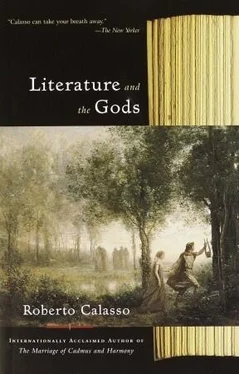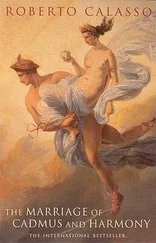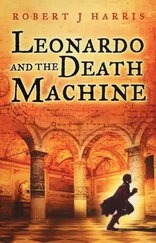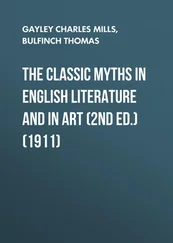The territory that this sonnet sets out to conquer is certainly not that of the virtuoso sequence of ix rhymes. The poets of the Baroque, after all, had produced any number of such feats, and a trip to the library would have more than satisfied anyone’s desires for that kind of thing. Nor is it the play of refractions, the “mirage within the words themselves,” to use the precept that Mallarmé explained thus: “I believe that … what we should be aiming for above all in poetry is to have the words reflect each other to the point that they no longer retain their own color but can only be seen as transitions in a spectrum.” This rule would apply to all Mallarmé’s poetry: but to understand it we must first establish the space within which the rule operates.
To help us approach that space, we have at our disposal — and it’s a rare privilege indeed — a paraphrase of this least paraphrasable of sonnets, written by the author himself. Mallarmé wrote it because the sonnet was to be included in a collection of poems by various authors, each poem being printed beside an etching. He wanted his illustration to be “full of Dream and Emptiness”; and to help the eventual artist, who in fact never materialized, because the poem was rejected, no doubt because considered incomprehensible, Mallarmé paraphrased his poem thus:
For example, an open window at night, the two shutters secured; a room with no one in it, despite the stable atmosphere produced by the secured shutters, and in a night made of absence and questioning, no furniture, except perhaps some plausible hint of vague consoles , a frame, combative, with death throes, around a mirror hung in the background, with its reflection, starry and incomprehensible, of the Ursa Major, the Great Bear, that connects this abandoned lodging of the world to the sky alone.
This paraphrase, itself an enchanted shred of prose, refers to the one lyric of which Mallarmé declared that he didn’t even know if it made sense or not, and that even if it didn’t the author nevertheless “would take comfort from it … thanks to the amount of poetry that it contains.” All of which will serve as the definitive demonstration that the only acceptable paraphrase is not the one that results from the improvident determination to translate a poem into some supposed meaning, but on the contrary a literary genre in its own right . And one that in this case is especially precious to us, because it states the implicit subject of the poem: the “room with no one in it.” It has been observed that from the upheaval of 1866 on, Mallarmé’s poetry abandons the outside world and shuts itself away in a room. But what is this room that coincides with the very space of the poem? Could it be that room “with no one in it,” inhabited only by a mirror? And who was it who just left that room, a few seconds, or millennia, ago?
There is a very strong and very ancient emotion that is rarely mentioned or recognized: it is the anguish we feel for the absence of idols. If the eye has no image on which to rest, if there is nothing to mediate between the mental phantasm and that which simply is, then a subtle despondency creeps in. This is the atmosphere that reigns in the first dream of which we have a record, a dream told by a woman, Addudûri, overseer of the palace of Mari in Mesopotamia, in a letter etched on clay tablets more than three thousand years ago. “In my dream I had gone into the temple of the goddess Bêllit-ekallim; but the statue of Bêllitekallim wasn’t there! Nor were the statues of the other divinities that normally stand beside Her. Faced with this sight I wept and wept.” The first of all dreams speaks of an empty temple, like Mallarmé’s empty room. The statues have been carried off, deported perhaps, along with the people who worshiped them. That kind of thing happened then. Loss precedes presence: every image must abide by this rule. And this helps us understand why literature, guardian of every space haunted by phantoms, has so adroitly searched out those fugitive idols and restored them to their pedestals.
And the mirror? Mightn’t that too be inhabited? Let’s take a look. Along the frame we see the perennial pursuit, tussle, and flight of gods, Nymphs, and fabled beasts. In the center — on the surface of the mirror — a vast, deep emptiness, where seven bright points tremble, like seven pupils: they are the reflection of the Ursa Major, the Great Bear, and thus of the seven  who keep watch over the cosmos and are its ever wakeful consciousness. Once again Mallarmé has gone back to something before the gods, for the
who keep watch over the cosmos and are its ever wakeful consciousness. Once again Mallarmé has gone back to something before the gods, for the  are also the seven breaths that, uniting together, compose Prajāpati. All that is going on in the soft gilt glow of the mirror’s frame — the divine melee — as likewise all that is going on in the darkness of the night outside the windows — the world, which is itself a frame — is equally open to their gaze. Which is the pure fact of consciousness, cut off from all else. Did Mallarmé mean to allude to the
are also the seven breaths that, uniting together, compose Prajāpati. All that is going on in the soft gilt glow of the mirror’s frame — the divine melee — as likewise all that is going on in the darkness of the night outside the windows — the world, which is itself a frame — is equally open to their gaze. Which is the pure fact of consciousness, cut off from all else. Did Mallarmé mean to allude to the  ? Wasn’t it only years later that he began to read some Indian texts? It’s unlikely that we will ever know for certain. But does it matter? The
? Wasn’t it only years later that he began to read some Indian texts? It’s unlikely that we will ever know for certain. But does it matter? The  belong to the Ursa Major: one only need rediscover them. Where the constellation is, there they are. And what can we say of the mirror they appear in? Here it’s hard not to see a reference to the Venetian mirror Mallarmé himself was engulfed in, as he described, during his first exploration of the shadow lands of literature. One day, he told his friend Cazalis, he saw himself again in that mirror “the same person I had forgotten months before.” But this having been absent from the mirror would be one of the premises underlying all his poetry. The sonnet records the continuing absence of the poet. And as we read it, words that had seemed obscure now ring out to us with sudden clarity: “a disposition of the Spiritual Universe to see itself and develop itself, through what I was.” Isn’t it this that has found its “objective correlative” in the sonnet? What is left is the world (the night sensed without), an empty room (the hollow shell, as it were, of the vanished author), and the reflection of the seven stars in a mirror, “de scintillations le septuor”: thus the mind manifests itself, nor will its wakefulness ever be more sharply discernible.
belong to the Ursa Major: one only need rediscover them. Where the constellation is, there they are. And what can we say of the mirror they appear in? Here it’s hard not to see a reference to the Venetian mirror Mallarmé himself was engulfed in, as he described, during his first exploration of the shadow lands of literature. One day, he told his friend Cazalis, he saw himself again in that mirror “the same person I had forgotten months before.” But this having been absent from the mirror would be one of the premises underlying all his poetry. The sonnet records the continuing absence of the poet. And as we read it, words that had seemed obscure now ring out to us with sudden clarity: “a disposition of the Spiritual Universe to see itself and develop itself, through what I was.” Isn’t it this that has found its “objective correlative” in the sonnet? What is left is the world (the night sensed without), an empty room (the hollow shell, as it were, of the vanished author), and the reflection of the seven stars in a mirror, “de scintillations le septuor”: thus the mind manifests itself, nor will its wakefulness ever be more sharply discernible.

Mallarmé in Oxford
On March 1st, 1894, in Oxford, and before an audience of about sixty people, dotted here and there with a few professors but mainly made up, as he himself would put it, of ladies “looking for a chance to hear spoken French,” Mallarmé gave the lecture generally known as “La Musique et les Lettres.” Having been invited to give “some information on various aspects of the current state of literature,” he took this journalistic task quite literally and began with an announcement that sounded like a newspaper headline:
“In fact I bring news. The most surprising news. Nothing like this has ever happened. On a touché au vers . Verse is under attack.”
There is a wonderful irony in that on , for as with the report of some terrorist attack, an uncertainty over the perpetrator increases our sense of terror. And then that touché —such a physical verb! And one that presupposes, for verse, a previous state of untouchability. Whereas now apparently it is entering a phase of promiscuity. Mallarmé then proceeds with his parody of a front page, but this time taking the leader column as his model: “Governments change; prosody remains ever intact: whether because during revolutions it passes unobserved, or because the attack doesn’t imply that this ultimate dogma may change.” Then he apologized for his jerky and breathless delivery, like someone who has seen an accident and is desperate to talk about it, with a distress proportional to the gravity of the event: “for verse is everything, to those who write.” Mallarmé doesn’t say “to those who are poets”; he says “to those who write.” Premise: prose itself is “a broken verse, which plays with its timbres and its concealed rhymes too.” The statement is followed by a few technicalities, then a final flicker: “for every soul is a rhythmical knot.”
Читать дальше

 who keep watch over the cosmos and are its ever wakeful consciousness. Once again Mallarmé has gone back to something before the gods, for the
who keep watch over the cosmos and are its ever wakeful consciousness. Once again Mallarmé has gone back to something before the gods, for the  are also the seven breaths that, uniting together, compose Prajāpati. All that is going on in the soft gilt glow of the mirror’s frame — the divine melee — as likewise all that is going on in the darkness of the night outside the windows — the world, which is itself a frame — is equally open to their gaze. Which is the pure fact of consciousness, cut off from all else. Did Mallarmé mean to allude to the
are also the seven breaths that, uniting together, compose Prajāpati. All that is going on in the soft gilt glow of the mirror’s frame — the divine melee — as likewise all that is going on in the darkness of the night outside the windows — the world, which is itself a frame — is equally open to their gaze. Which is the pure fact of consciousness, cut off from all else. Did Mallarmé mean to allude to the  ? Wasn’t it only years later that he began to read some Indian texts? It’s unlikely that we will ever know for certain. But does it matter? The
? Wasn’t it only years later that he began to read some Indian texts? It’s unlikely that we will ever know for certain. But does it matter? The  belong to the Ursa Major: one only need rediscover them. Where the constellation is, there they are. And what can we say of the mirror they appear in? Here it’s hard not to see a reference to the Venetian mirror Mallarmé himself was engulfed in, as he described, during his first exploration of the shadow lands of literature. One day, he told his friend Cazalis, he saw himself again in that mirror “the same person I had forgotten months before.” But this having been absent from the mirror would be one of the premises underlying all his poetry. The sonnet records the continuing absence of the poet. And as we read it, words that had seemed obscure now ring out to us with sudden clarity: “a disposition of the Spiritual Universe to see itself and develop itself, through what I was.” Isn’t it this that has found its “objective correlative” in the sonnet? What is left is the world (the night sensed without), an empty room (the hollow shell, as it were, of the vanished author), and the reflection of the seven stars in a mirror, “de scintillations le septuor”: thus the mind manifests itself, nor will its wakefulness ever be more sharply discernible.
belong to the Ursa Major: one only need rediscover them. Where the constellation is, there they are. And what can we say of the mirror they appear in? Here it’s hard not to see a reference to the Venetian mirror Mallarmé himself was engulfed in, as he described, during his first exploration of the shadow lands of literature. One day, he told his friend Cazalis, he saw himself again in that mirror “the same person I had forgotten months before.” But this having been absent from the mirror would be one of the premises underlying all his poetry. The sonnet records the continuing absence of the poet. And as we read it, words that had seemed obscure now ring out to us with sudden clarity: “a disposition of the Spiritual Universe to see itself and develop itself, through what I was.” Isn’t it this that has found its “objective correlative” in the sonnet? What is left is the world (the night sensed without), an empty room (the hollow shell, as it were, of the vanished author), and the reflection of the seven stars in a mirror, “de scintillations le septuor”: thus the mind manifests itself, nor will its wakefulness ever be more sharply discernible.










